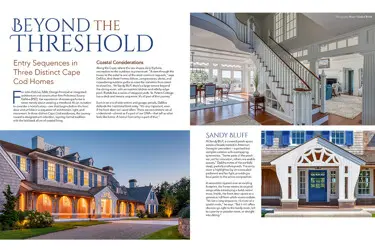Riptide
Separated from Shore Road by stonewalls and sweeping lawn, and from Chatham Harbor by a tall bluff, the high visibility location and the grand 1930’s transformation made Riptide a Cape Cod icon. Through subsequent additions and alterations, including a previous renovation by PSD, it has remained iconic ever since. When the current owners bought the house, they wanted to adapt it to meet their needs and reflect their character but also wanted to maintain the Colonial Revival forms and details that confer this status.

| Project Category | Renovation |
|---|---|
| Scope of Work | Architecture, Landscape Architecture, Construction |
| Finished Space Above Grade | 6,045 |
| Photography | Brian Vanden Brink |

Some houses both define and are defined by their region and their time. Riptide is one of those houses.
It began its life as an early 20th century bungalow, with a broad roof, big overhangs, and craftsman style details. A few decades later, spurred on by Sesquicentennial interest in the founding of the country, the Colonial Revival style gained popularity. The related “Old Cape Cod” myth was also a creation of the first half of the 20th century, and was developed by authors like Joseph Lincoln (who lived right next door), and artist John Cuthbert Hare (a member of the Provincetown Art Colony). With such historicist ideas at the forefront, Riptide’s 1930’s owners transformed the bungalow into a substantial Colonial Revival house. They even reused fireplace surrounds and paneling from another colonial era house. These details remain today.


The new owners also sought to fix a long standing planning flaw.
The front door location of the 1930’s faced the side yard, making it invisible from Shore Road. PSD designed an arbor for the previous owner directing people to the entry, but now the front entry has been moved altogether to face Shore Road. A welcoming front porch glows like a lantern at night and a large scale fan light shaped screen wall gives the entry the scale necessary to have impact across the large front yard. A clear path to an ocean view exists from the front door through the depth of the house. The old main entry now opens to a protected garden featuring a large marble whale’s tale sculpture by stone carver Tim Dibble.






For the interior, the owners requested a house that was part Beacon Hill and part Cape Cod beach house.
The curving staircase in a dramatic new open entry/stair hall nods to Beacon Hill style. As you move toward the ocean the spaces get more informal and playful. The cathedral-ceiling family room and new screened-in porch have panoramic harbor, sand bar, and ocean views. They feel more like spaces for lounging after a day at the beach or on the clam-flats.




The primary suite includes a sitting room with a window seat, cove lighting, and a light monitor above.
The primary sleeping space remains in its previous location but has been opened up into the roof above for light, airiness, and drama. The sitting and sleeping spaces connect through an opening just beyond the bed.




A large flying eagle weathervane, symbolic of the owners alma mater, announces the home at the scale of the harbor—sending rays of reflected light off its flat gold-leafed profile and reassuring boaters that the old icon called Riptide is still there, renewed for generations to come.




